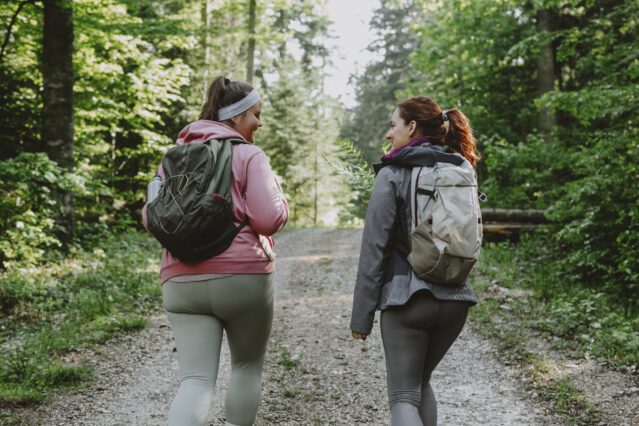I’ve often said that walking is the human condition, but I’d like to amend that to be more accurate: loaded walking—or rucking—is the human condition. Normal unloaded walking is an important part of being an active, able human and lays the ideal foundation for a healthy fitness level. However, it can and should be elevated with occasional (or regular) walking while bearing weight.
For example, when hunting-gathering hominids walked the 12 miles back from a successful hunt, they carried the 40-pound haunch of the antelope on their shoulders—or the woven basket full of tubers, fruits, and honeycomb. When Roman legionnaires marched 18.5 miles in a day they also carried a pack weighing 45 pounds. Then they proceeded to build a defensive fort for two hours. When kids walked to school (before the ubiquity of miles-long SUV-laden drop off lines), they wore bags full of books.
Hell, the entire premise of obligate bipedalism is that it lets you walk while carrying things–tools, building materials, shelter materials, weapons, food, meat, foraged plants, and roots. These are all essential objects to be carried by bipedal humans, all increasing the pull of gravity that you must then resist.
Why You Should Ruck
Today we load our food into car trunks and drive it home—or, worse, we have it delivered to our doorstep. We drop our kids off at school and pick them up. We drive to manicured trailheads, walk for miles, and have our air-conditioned car waiting to take us back home with a smoothie stop along the way. We park at campsites and complain about the 100-yard walk in.
Now, these aren’t “bad,” but they are novel environments to the human genome that make us weaker and more vulnerable to stressors in general. As with everything, if we want to get better, stronger, and healthier despite modern comforts, we have to impose arbitrary and artificial boundaries on ourselves. One great way to do that and replicate the ancestral loaded walking environment, is to go rucking. Rucking is wearing a weighted backpack while going for walks and hikes. That’s it. And when you ruck, you’ll start seeing some real benefits.
Rucking builds grit.
It’s a total body workout that makes you stronger, fitter, faster, and everything else, but lots of exercises do that. Heck, almost all of them do. Rucking builds that intangible quality I can only describe as grit or toughness. Because rucking is hard.
Rucking makes you stronger.
You are moving under added weight—the oldest recipe in the book for getting stronger.
A rucking workout is a great way to enhance cardio without increasing speed.
It’s sort of a low/high intensity workout. It’s high intensity because you’re bearing more weight. It’s low intensity because you’re moving at walking pace. Particularly uphill/downhill rucking is a fantastic cardio workout and, if you do it carefully, easier on the joints than you might think.
How to Ruck
If you stopped reading right now and just went out wearing a heavy backpack on walks and hikes, you’d probably be okay. But there are some extra details and tips I can give that you might find helpful.
1. Get a rucksack
You can ruck with any sturdy backpack filled with rocks, sandbags, books, or weights. But if you’re really serious about it, I’d recommend a devoted rucking bag. These are solid backpacks called rucksacks designed to handle and distribute heavy loads across the body. They usually have proprietary weights that fit perfectly in the rucksack, so that the load is balanced and even.
The best-regarded brand is Go Ruck. It’s the only one I can recommend because it’s the only one I’ve ever tried, but I’m sure there are others you can use.
2. Start small—5-10 pounds less than you think you can handle
You can always add more weight the next time, but if you get in deep water with too much weight, you’ll have a bad time making it back.
3. Choose the right route
A good rule is to start rucking on a walking or hiking route you could do in your sleep. Choose one that’s already easy for you unweighted and that you enjoy doing. Don’t consider it to be a “workout.” Afterward, you can make it harder.
4. Perfect your gait and walking technique
Any small perturbations to your walking technique or gait will be magnified by the added weight, as will any damage to your joints or strains to your muscles.
Remember, rucking is loaded walking. Don’t run. Regular running with 30-40 pounds on your back is a recipe for injuries. It won’t happen to everyone, but it happens to enough people that it’s not worthy testing your luck. It’s far better to walk with weight and save the running for unweighted outings.
5. Don’t overdo it
Rucking is training; it’s not an event. When you train for anything, you don’t want to go to failure. You don’t want to leave everything on the field. Going all out like that is for competition (or life and death situations). Training is to make you stronger so when those serious situations occur, you can handle them. Leave some in the tank.
6. Gradually increase your weight
Remember to start small and once you feel comfortable, increase your weight.
- Beginners: 10-15 pound ruck along a route that you’ve done many times before comfortably
- Intermediate: 20-30 pound ruck along a route that you’ve done many times before comfortably
- Advanced: 30-50 pound ruck along a route that you’ve done many times before comfortably
7. Tackle hills
I find that rucking uphill (and then downhill) is an incredible workout. Surprisingly, it feels better and more productive than rucking on flat ground.
Rucking Alternatives
You don’t necessarily have to buy a rucking backpack, or even wear a backpack at all. There are other options for loaded walking:
- Carry a large tree branch or log across your shoulder: The best part of this is that they’re usually free for the taking on hikes and you don’t have to bring it back home with you. Just find a suitable branch or log and carry it as long as you like and then dump it on the ground when you’re done. This also works with large rocks.
- Take a friend and a kettlebell with you: When one of you gets tired, hand it off. When the other person gets tired, it’s your turn again. Continue on until the walk is over.
- Wear a weighted vest: This is a difference type of weight distribution, placing some of the weight across the front of your body, which brings its own challenges.
- Load a sandbag or duffel bag: You can fill it with sand or gravel and carry it on your walks. Switch from shoulder to shoulder, hug it to your body, carry it like you’re carrying a bride across the threshold, or drape it over both shoulders. Just keep it up there, however you can, and walk with it.
- Use a normal backpack loaded with weights: This isn’t going to be nearly as comfortable as a rucksack. The straps will dig into your shoulders, there won’t be as much load distributed to the hips, and the bag itself might break. But it does work if you’re in a pinch.
If you want to step it up a notch load a loosely-packed sandbag on top of your ruck to take your workout to the next level.
There are dozens of ways to load your walks with weight, the rucksack being the most comfortable and approachable. But the point is: incorporate loaded walks into your schedule and see your fitness skyrocket and your connection to our ancestral past solidify.
Take care, everyone. I’d love to hear about your experiences with loaded walks or rucks.
About the Author
Mark Sisson is the founder of Mark’s Daily Apple, godfather to the Primal food and lifestyle movement, and the New York Times bestselling author of The Keto Reset Diet. His latest book is Keto for Life, where he discusses how he combines the keto diet with a Primal lifestyle for optimal health and longevity. Mark is the author of numerous other books as well, including The Primal Blueprint, which was credited with turbocharging the growth of the primal/paleo movement back in 2009. After spending three decades researching and educating folks on why food is the key component to achieving and maintaining optimal wellness, Mark launched Primal Kitchen, a real-food company that creates Primal/paleo, keto, and Whole30-friendly kitchen staples.
Post navigation
If you’d like to add an avatar to all of your comments click here!
Source by www.marksdailyapple.com



